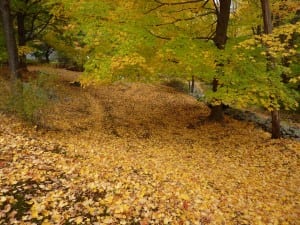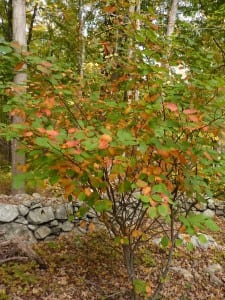Temperature, cloud cover and rainfall impact leaf color intensity and duration
By Pamela Doan
It’s leaf-peeping season and just because we live in an area rich with color and don’t need a getaway to enjoy fall’s delights doesn’t mean we’re immune to its charms, either. On a trip to Ithaca last week, the Catskills were showing more bare limbs and color than a trip down the Hudson to Manhattan would yield right now. Even in a microclimate like Stonecrop Gardens or the mountains north of Route 9 around Fahnestock State Park, these areas are showing more fallen leaves and advanced color than Main Street in Cold Spring. The diversity of our topography offers a changing vista everywhere you turn.

The glory of a landscape in fall is much more interesting when you take into account the complex processes that produce it as well. Tree leaves change color in fall in response to changes in daylight and temperature. The lower angle of the sun and shortening daylight hours signal trees and plants to stop making food. Chlorophyll, a chemical in the cell of leaves that transforms the sun’s energy into food production through photosynthesis, makes leaves green.
When it starts to break down, the yellow, orange and red colors come out in the leaf. The color of the leaf will be determined by the mixture of pigments in the leaf and varying amounts of chlorophyll. The same substances that give fruits and vegetables their color are present in tree leaves, too. Carotenoids, which give carrots and corn their yellow and orange hues, and anthocyanins, which make tomatoes and strawberries red, are the other pigments, but anthocyanins are not in all leaves.
Temperature, cloud cover and rainfall all impact the intensity and duration of fall color. The recent run of bright, sunny days and warmer temperatures make for less intense leaf color. You can’t have it all, I guess. Cooler, cloudier and wetter fall weather makes for better color. New York’s tourism agency has a fall foliage tracker on their website if you want to plan a visit somewhere – fallgetaways.iloveny.com.
No sites in Putnam County are listed, but as of this week, Poughkeepsie is reporting 25 percent color and White Plains in Westchester is reporting 35 percent. The Adirondacks region is at peak color so go now if you’re looking for good photo opportunities.

Other plants can be very colorful at this time of year, too. Robin Wood, a horticulturist at Stonecrop Gardens said, “Some of our native vines like poison ivy and Virginia creeper can be quite showy. Viburnum, a shrub, and herbaceous plants like redwort and geranium sanguineum (also known by its common name “bloody cranesbill”) have nice fall colors, too.” Stonecrop visitors might note that fall is more advanced at the higher elevation than it is closer to the Hudson River. Lower elevations and proximity to the river create warmer conditions that make fall seem to last longer before winter’s onset.
While we’re on the topic of trees, a few things to note about fall tree care. After the thunderstorms that hit our area early in the week, it’s a good time to inspect trees for damage or weak limbs that could become dangerous during extreme weather. Contact an arborist for help if you haven’t had an assessment of the trees that are near buildings or areas that are frequently used.
All those leaves that are dropping can become wonderful mulch, too. I mention shredded leaves as mulch in this column frequently and it always bears repeating. Using the natural resources that are available in the landscape is environmentally responsible and also much more affordable than buying compost or wood chips. Straw is great winter mulch. Shredded leaves are better summer mulch. During the winter, leaves can become a haven for overwintering pests so find a good spot to store the leaves until spring and then spread them in the garden, flower beds or around the base of trees.
There’s still a good window of time to plant new trees, too. Natives like dogwood, redbud and shad all have spring flowers to add a pop of color in the landscape. Keep watering any newly planted trees into November to make sure they go into winter well hydrated. More than anything, take time to enjoy the season and appreciate the beauty of our natural resources. It won’t last long.
Photos by P. Doan
